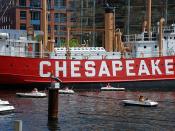Although colonists came to America for many of the same reasons, the experiences they encountered were quite different. The quest for economic opportunity, religious freedom, and democratic lifestyle presented challenges to both the Chesapeake and New England colonies.
The Chesapeake Colony consisted of Virginia and Maryland. Virginia's first migrants were sent not only to settle land, but more importantly to search for gold and other treasures for trade to fund a joint-stock company owned by London merchants. The merchants had sold shares of their company to investors in order to providing funding for this venture. An additional promise of the merchants to the stockholders was that Christianity would be introduced to the Indians while settling the new land. No women, settlers, or ministers were included in the first settlement. The original colonists consisted of 104 young men and boys who were employed by the London merchants. While the merchants retained ownership of the land, a governor and small council were appointed to govern the "employees."
These employees were in reality fur traders and wildly adventurous young men in pursuit of gold and land for themselves. They were ill prepared to handle the challenges they encountered in Virginia. They were expected to provide their own food, but had no experience living off the land. Living conditions in Virginia were not as they expected. Disease and starvation cost many of these men their lives. The land of Virginia was swampy, the water was bad and there was an inadequate supply of food and shelter. The swampy land encouraged the spread of disease by mosquitoes. Although there was a shortage of food, the young settlers didn't want any part of farming. They were in pursuit of gold. Conflicts with the Indians began when the colonists stole food from them. The majority of...


